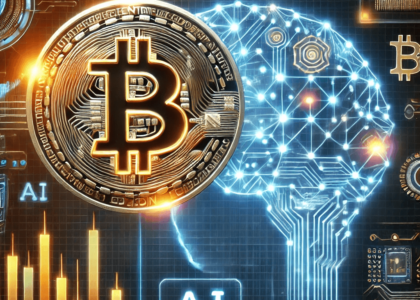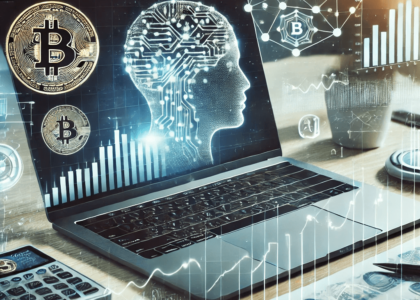Introduction
Artificial Intelligence (AI) is transforming the financial markets, making AI Trading one of the most innovative developments in the industry. With AI-driven algorithms, neural networks, and predictive analytics, traders can leverage data like never before. But what exactly is AI Trading, and how does it work? In this guide, we’ll explore the fundamentals of AI Trading, its applications in finance, and how AI Trading Signals are shaping the future of investing.
What is AI Trading and How Does It Work?
AI Trading, also known as algorithmic trading powered by AI, refers to the use of machine learning and deep learning techniques to analyze financial data and execute trades automatically. Unlike traditional algorithmic trading, AI Trading models can learn from past data and adapt their strategies over time.
Key Components of AI Trading
Data Collection & Analysis: AI models process vast amounts of market data, including price movements, historical trends, and real-time news.
Machine Learning Algorithms: AI models identify patterns that may indicate future price movements.
Automated Execution: AI-powered trading bots execute trades automatically based on predefined strategies.
Risk Management: AI Trading platforms use AI to minimize losses and optimize returns.
Sentiment Analysis: AI scans financial news and social media platforms to assess market sentiment and predict trends.
Portfolio Optimization: AI adjusts trading strategies to maximize profits while minimizing risk.
Anomaly Detection: AI detects unusual market behaviors that could indicate profitable opportunities.
High-Frequency Trading (HFT): AI enables rapid, high-volume trades that capitalize on micro-movements in the market.
AI-Powered Arbitrage: AI identifies pricing inefficiencies between different exchanges and executes trades for risk-free profits.
Reinforcement Learning: AI continuously refines trading strategies through self-learning algorithms.
Neural Networks in Finance
Neural networks, a subfield of machine learning, play a crucial role in AI Trading. These deep learning models mimic the human brain’s ability to recognize patterns, allowing them to make highly accurate market predictions.
How Neural Networks Improve AI Trading
Pattern Recognition: AI identifies bullish and bearish patterns more effectively than human traders.
Sentiment Analysis: AI scans financial news and social media to gauge market sentiment.
High-Frequency Trading (HFT): AI optimizes trade execution at millisecond speeds.
Predictive Analysis: Neural networks analyze past financial data to forecast market trends.
Anomaly Detection: AI detects unusual market behaviors that could indicate profitable opportunities.
Adaptive Learning: AI continuously improves its trading strategies through reinforcement learning.
Quantitative Analysis: AI models calculate risk-adjusted returns and optimize trading portfolios.
Macroeconomic Forecasting: AI analyzes economic indicators to predict future market conditions.
Automated Risk Adjustments: AI detects changing market conditions and dynamically adjusts portfolio risk levels.
Deep Learning for Market Scenarios: AI simulates various economic conditions to predict potential market shifts.
Advanced AI Trading Strategies
While basic AI strategies focus on automating simple buy/sell decisions, advanced techniques allow traders to maximize their profits through more sophisticated trading models.
Quantum AI Trading: AI models using quantum computing can process millions of variables simultaneously, offering superior market predictions.
AI-Powered Statistical Arbitrage: AI analyzes price deviations between correlated assets and executes trades in real time to exploit inefficiencies.
Automated Mean Reversion Strategies: AI detects overbought and oversold conditions, optimizing trades to capitalize on price corrections.
AI-Based Volatility Trading: AI tracks volatility trends to suggest trading strategies in highly fluctuating markets.
Neural Network Portfolio Balancing: AI continuously adjusts portfolio weightings based on live market conditions and risk appetite.
Reinforcement Learning-Based Trading: AI models adapt based on prior performance, optimizing future trade execution dynamically.
AI-Driven Dark Pool Trading: AI analyzes off-market trades in private exchanges (dark pools) to predict institutional activity.
Liquidity-Based Order Execution: AI minimizes slippage by adjusting trade execution based on real-time liquidity conditions.
The Role of Regulations in AI Trading
Governments and financial institutions worldwide are closely monitoring the growth of AI Trading. With the increasing role of AI in finance, regulators are introducing new frameworks to ensure transparency and market stability.
SEC & CFTC in the US: Monitoring algorithmic trading to prevent market manipulation.
EU’s AI Act: Aims to regulate AI systems in finance to prevent systemic risks.
Asia-Pacific Regulations: Countries like Singapore and Japan are integrating AI monitoring tools in financial regulations.
Financial Stability Board (FSB): International efforts to assess AI risk in financial markets.
Regulatory Sandbox Initiatives: Some governments allow AI trading firms to test algorithms under controlled environments.
While regulation can slow innovation, it also provides greater trust and security in AI-powered financial markets.
Case Studies: Companies Using AI Trading Successfully
Case Study 1: Renaissance Technologies
Renaissance Technologies is a hedge fund that uses AI and machine learning to drive its Medallion Fund, which has consistently outperformed the market with annualized returns exceeding 60%. By leveraging deep learning, sentiment analysis, and algorithmic execution, the firm dominates quantitative trading.
Case Study 2: Bridgewater Associates
Bridgewater Associates, one of the largest hedge funds, has integrated AI into its investment strategies to analyze macroeconomic data and predict global market movements. Its AI-driven models process vast datasets to optimize risk management and portfolio allocation.
Case Study 3: Two Sigma
Two Sigma relies on AI trading strategies that process petabytes of data daily, identifying patterns in equities, commodities, and forex markets. The firm uses reinforcement learning models to adjust trading positions dynamically.
How to Get Started with AI Trading
For traders looking to implement AI Trading into their strategy, here are key steps:
Choose the Right AI Trading Platform: Research and compare platforms like TradeSanta, QuantConnect, and CryptoHopper.
Start with Paper Trading: Test AI-driven strategies using simulated environments before committing real funds.
Use Backtesting Tools: AI trading platforms offer historical data analysis to refine strategies.
Combine AI with Manual Oversight: AI is a powerful tool, but human supervision remains critical.
Stay Updated with Market Trends: AI models are only as good as the data they process.
Understand AI Trading Risks: Be aware of AI overfitting, regulatory changes, and potential cybersecurity threats.
Join AI Trading Communities: Platforms like Quantopian, Medium, and Discord offer valuable insights from other AI traders.
Conclusion
AI Trading is reshaping the financial industry by providing more precise, data-driven insights. Neural networks and AI Trading Signals offer traders unparalleled advantages in speed, accuracy, and efficiency. As AI technology continues to evolve, so will its impact on financial markets.
Are you ready to leverage AI Trading for your investments? Stay updated with the latest AI Trading insights at EdgeAIHub.net and take your trading strategies to the next level!






